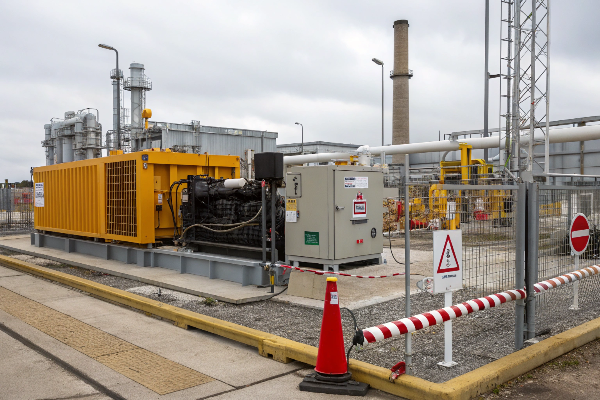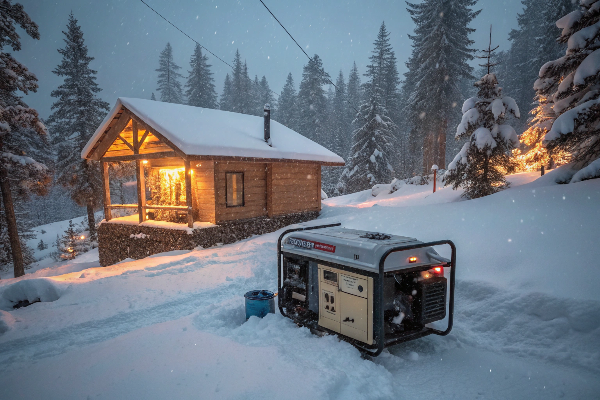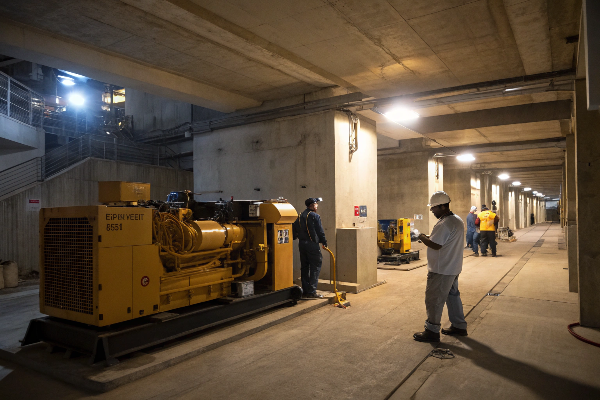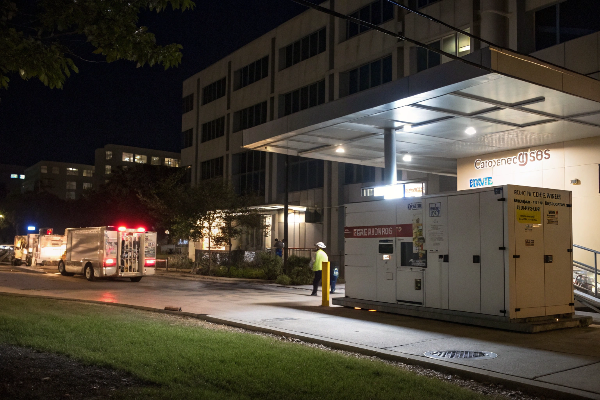
Seeing black smoke from your diesel generator is a problem. It means something is wrong.
Black smoke from a diesel generator usually indicates incomplete combustion, often caused by issues with the fuel system, air intake, or incorrect engine loading.
It is a sign to investigate.
Let us find the reasons.
How Do Fuel Injection System Issues Cause Black Smoke?
Can problems with how fuel gets into the engine make black smoke appear?
Issues within the fuel injection system1, such as clogged injectors2 or incorrect injection timing3, can prevent fuel from burning completely, resulting in the emission of black smoke.

Fuel System Problems Explained
For a diesel engine to run cleanly, the right amount of fuel must be injected into the cylinder at exactly the right time, in a finely atomized spray. If anything goes wrong with this process, the fuel will not mix properly with the air and will not burn completely. Unburned carbon particles then exit the exhaust as black smoke. One common issue is clogged or worn fuel injectors. Injectors are like tiny nozzles that spray diesel fuel into the combustion chamber under very high pressure. The holes in the nozzle are very small to create a fine mist. If these holes get clogged with dirt, carbon deposits, or varnish from poor quality fuel, the spray pattern gets distorted. Instead of a fine mist, you might get streams or larger droplets of fuel. These larger droplets do not vaporize quickly and do not mix well with the air. They burn only partially, creating soot. I have seen this issue many times when generators have used fuel that wasn't filtered properly or has been stored for a long time without treatment. For our distribution partners, emphasizing the importance of clean fuel and regular fuel filter changes is key to preventing this.
Incorrect fuel injection timing is another major cause of black smoke. The fuel injection system is timed precisely to inject fuel when the piston is in the right position and the air is hot enough from compression. If the timing is off – meaning the fuel is injected too early or too late – the combustion process is not optimized. If injected too early, the pressure and temperature in the cylinder might not be high enough for complete burning. If injected too late, there is not enough time for all the fuel to burn before the exhaust valve opens. Both situations lead to incomplete combustion and black smoke. Modern electronic fuel injection systems control timing very precisely, but issues with sensors or the engine control unit (ECU) can still cause timing problems. Older mechanical injection systems rely on physical adjustments which can drift over time. For project execution entities maintaining generators on site, checking and adjusting fuel injection timing is a task for trained technicians. It is a complex system that needs precise settings.
Common Fuel System Issues Leading to Black Smoke
- Clogged Injectors: Distorted spray pattern leads to poor fuel-air mix.
- Worn Injectors: Enlarged or damaged nozzle holes cause poor atomization.
- Incorrect Injection Timing: Fuel injected too early or too late for optimal burn.
- Low Fuel Pressure: Not enough pressure for proper atomization.
- Faulty Fuel Pump: Cannot deliver fuel at the correct pressure/volume.
- Air in Fuel System: Can disrupt fuel delivery and pressure.
- Contaminated Fuel: Dirt, water, or poor quality fuel damages injectors and affects burning.
Based on my experience, fuel quality and maintenance are critical. Using clean, filtered diesel and changing fuel filters regularly are the simplest ways to prevent many fuel injection issues that cause black smoke. For distribution partners selling generators in areas where fuel quality might be inconsistent, advising customers on fuel storage and filtration solutions is very helpful. We design our H&C generators to handle standard industrial diesel fuel, but cleanliness is always important. If a project procurement partner is seeing black smoke, one of the first things I ask about is the fuel source and the maintenance history of the fuel filters and injectors. A quick check can often identify the problem.
| Fuel System Component | Potential Issue | How it Causes Black Smoke |
|---|---|---|
| Fuel Injectors | Clogged, worn, leaking | Poor spray pattern, incomplete fuel vaporization |
| Fuel Pump | Low pressure, inconsistent flow | Insufficient fuel atomization pressure |
| Fuel Filters | Clogged | Reduced fuel flow, potential pressure drops |
| Injection Timing | Advanced or retarded | Fuel injected at wrong point in combustion cycle |
| Fuel Quality | Contaminants, water | Damages components, affects burning properties |
So, if your generator is smoking black, check the fuel system. Make sure the fuel is clean and the injectors are spraying correctly at the right time.
What Role Do Air Intake Restrictions Play in Causing Black Smoke?
Can the engine not getting enough clean air make it smoke black?
Yes, anything that restricts the flow of clean air into the engine, such as a dirty air filter or problems with the turbocharger, can lead to an air-fuel mixture that is too rich, causing incomplete combustion and black smoke.

Airflow Problems and Black Smoke
Diesel engines need a lot of air for proper combustion. They run lean compared to gasoline engines, meaning they use much more air per unit of fuel. If the engine does not get enough air, the air-fuel ratio becomes too rich – too much fuel for the available air. This is like trying to burn a fire without enough oxygen; you get a lot of smoke. A very common reason for not enough air is a restricted air intake. The air filter is the first place to check. Its job is to clean the air before it enters the engine. If the air filter is clogged with dust, dirt, or debris, it prevents air from flowing freely. The engine struggles to pull in enough air, especially at higher loads. This results in a rich mixture and black smoke. Changing the air filter is a simple and often overlooked maintenance task. For project execution entities operating in dusty environments, checking and replacing air filters frequently is essential to prevent black smoke and maintain engine performance.
Another critical component in the air intake system is the turbocharger. Most modern industrial diesel generators use turbochargers to force more air into the cylinders. A turbocharger is powered by the engine's exhaust gases. It spins a turbine, which in turn spins a compressor that pushes extra air into the engine. If the turbocharger is not working correctly – perhaps the turbine is damaged, the bearings are worn, or there is a leak in the intake piping after the turbo – it will not deliver enough boost pressure. The engine will then be starved of air, leading to a rich mixture and black smoke. Issues like leaky intake hoses or intercooler problems (if equipped) also prevent sufficient air from reaching the cylinders. Any restriction or failure in the path of air from the atmosphere to the cylinder can cause black smoke.
Common Air Intake Issues Leading to Black Smoke
- Clogged Air Filter4: Prevents sufficient air from entering the engine.
- Faulty Turbocharger5: Not producing enough boost pressure.
- Intake Leaks6: Unmetered air loss after the turbo, reducing air reaching cylinders.
- Blocked Intercooler/Charge Air Cooler: Reduces the amount of cool, dense air entering the engine.
- Restricted Intake Ducting: Physical blockages in the pipes leading to the air filter or turbo.
Based on my experience, black smoke is often a sign of either a fuel issue (too much fuel or poor spray) or an air issue (not enough air). Checking the air filter is the easiest first step. If that does not fix it, looking at the turbocharger and the rest of the intake system is next. For distribution partners, educating clients on the importance of the air filter in diesel generators is important. It is a relatively inexpensive part to replace, and neglecting it can lead to significant performance issues and black smoke. For project procurement partners, ensuring the generator unit comes with a robust air filtration system suitable for the operating environment (e.g., heavy-duty filters for dusty sites) is a good practice. We select air filters and turbochargers for our H&C generators to ensure adequate airflow even under demanding conditions, but maintenance is still required.
| Air Intake Component | Potential Issue | How it Causes Black Smoke |
|---|---|---|
| Air Filter | Clogged with dirt/debris | Restricts airflow into the engine |
| Turbocharger | Damaged, worn, failing | Fails to compress and deliver enough air |
| Intake Piping | Leaks, blockages | Air loss or restriction before reaching cylinders |
| Intercooler/Cooler | Clogged, leaking | Reduces density and volume of air entering engine |
| Air Inlet Louvers | Blocked by debris | Prevents ambient air from reaching filter housing |
So, if the generator is smoking black, make sure it is getting plenty of clean air. Check the filter and the turbo.
How Can Engine Load Conditions Contribute to Black Smoke?
Can how hard the generator is working cause it to emit black smoke?
Operating a diesel generator under certain load conditions, such as severe overloading or prolonged running at very light loads, can contribute to incomplete combustion and result in black smoke emissions7.

Load Conditions and Black Smoke
How the generator is loaded can also affect its exhaust color. The most obvious load-related cause of black smoke is overloading. Every generator has a maximum power rating (kW and kVA). If you try to draw more power than the generator is designed to produce, the engine will be overloaded. It tries to compensate by injecting more fuel to meet the demand. However, the engine's capacity to use air is limited. It cannot pull in or force in enough extra air to burn the excess fuel completely. This leads to a very rich fuel-air mixture and significant black smoke. Severe overloading can also cause engine damage and voltage/frequency instability. It is a clear sign that the generator is too small for the job. This is why accurately calculating your power needs, including starting surges, is crucial, as discussed earlier. I always warn my clients against consistently overloading a generator; it is bad for the equipment and indicates a sizing error.
Running a diesel generator at very light loads for extended periods can also contribute to black smoke, although sometimes it is more blue-grey than pure black, often called "wet stacking8." When a diesel engine runs at a low percentage of its rated load (e.g., below 30-40%) for a long time, the combustion temperatures in the cylinders are lower than optimal. The fuel may not burn completely, leaving behind unburned or partially burned fuel and soot. This material can build up in the combustion chamber, on the piston rings, and in the exhaust system, including the turbocharger and muffler. Over time, this buildup, particularly in the exhaust, can restrict flow and worsen combustion, leading to black smoke even when the load increases slightly. Running at light load can also cause oil to leak past the piston rings more easily, contributing to the "wet stacking" which is a mix of unburned fuel and oil. Periodically loading the generator closer to its capacity ("exercising" it) can help burn off these deposits and reduce wet stacking and associated smoke.
Load-Related Causes of Black Smoke
- Overloading: Engine attempts to inject too much fuel relative to available air.
- Severe Transient Loads: Sudden, large load increases before the engine can respond fully with more air.
- Prolonged Light Loading (Wet Stacking): Low combustion temperatures lead to incomplete burn and deposits.
- Incorrect Governor Settings: Engine speed/fuel delivery not responding correctly to load changes.
For distribution partners, advising customers on proper generator sizing9 and the importance of regular load testing or exercising, especially for standby units that rarely run under significant load, is part of good service. For project execution entities, understanding the load profile of their equipment is important. If the load varies widely, they might need a generator with good transient response or consider having multiple smaller generators rather than one large one that often runs at light load. My experience indicates that while black smoke from a well-maintained generator can point to air or fuel problems, sometimes it is simply a result of how the generator is being used relative to its capacity. We design our H&C generators with robust engines and control systems to handle variable industrial loads, but operation within the specified load limits is always required for best performance and minimal emissions.
| Load Condition | Description | How it Causes Black Smoke |
|---|---|---|
| Overload | Load exceeds generator's capacity | Engine injects excess fuel without enough air |
| Severe Load Steps | Sudden large increase in demand | Temporary imbalance between fuel and air supply |
| Light Load (Prolonged) | Running below ~30-40% capacity | Low combustion temp, incomplete burn, deposits |
| Under-sizing | Generator too small for application | Frequent overloading becomes unavoidable |
So, make sure the generator is not overloaded and avoid running it at very low power for too long. Using the right size generator for the job helps prevent black smoke.
Conclusion
Black smoke means incomplete burning from fuel problems, lack of air, or wrong loading.
-
Understanding fuel injection system issues can help you troubleshoot black smoke problems effectively. Explore this resource for detailed insights. ↩
-
Learn how clogged injectors can lead to black smoke and other performance issues in diesel engines. This knowledge is crucial for maintenance. ↩
-
Discover the impact of incorrect injection timing on diesel engine performance and emissions. This is vital for proper generator operation. ↩
-
Understanding the impact of a clogged air filter can help you maintain engine efficiency and prevent black smoke. ↩
-
Learn how a faulty turbocharger can lead to performance issues and black smoke, ensuring your engine runs smoothly. ↩
-
Discover how intake leaks can compromise engine performance and lead to black smoke, helping you troubleshoot effectively. ↩
-
Understanding the causes of black smoke emissions can help you maintain your generator effectively and reduce pollution. ↩
-
Exploring wet stacking will provide insights into maintenance practices that can enhance your generator's efficiency and longevity. ↩
-
Proper generator sizing is crucial for optimal performance and avoiding issues like black smoke; learn how to size it correctly. ↩

